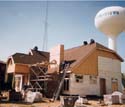We know NRCA is sensitive to misleading articles or reports that could damage the reputations of the roofing industry and its products. There is a history of potentially misleading reports and articles that have been used by regulators and legislators to restrict the use of roofing products. For example, an NRCA Special Report about asphalt fumes references a report about asphalt fumes that "may be used by some state authorities as a justification for increased regulatory scrutiny for asphalt fumes."
So it was with great interest we read "Working safely with SPF," May issue, page 70, by Harry Dietz, NRCA's director of risk management.
Although the article contains beneficial information about protecting workers and providing first aid in case of spills and exposure, Dietz makes two misleading comments concerning the exposure risks of spray polyurethane foam (SPF) materials.
First, Dietz writes, "components used in SPF roofing applications and certain top-coat products usually are characterized by the U.S. Department of Transportation [DOT] as Class 3 hazardous materials because of their flammable and toxic natures."
The liquid foam components of SPF roofing materials currently used are not regulated by DOT in quantities less than 5,000 pounds (2268 kg). A better measure of the relative flammability and health concerns of SPF liquid components is the National Fire Protection Association's (NFPA's) classifications. According to NFPA, manufacturers typically reported SPF as having classifications of 1 for reactivity, 1 for flammability and 2 for health on a four-point scale with 1 being the most benign and 4 being the most severe. Some solvent-based coatings, such as silicone or polyurethane, may be labeled as flammable and, accordingly, must be handled with some special requirements and cautions. Acrylic coatings are not labeled as flammable.
Second, Dietz reports, "Isocyanate contact with the eyes can cause permanent damage, and breathing vapors can lead to death."
Studies have shown the isocyanates used in SPF formulations do not cause permanent damage to the eyes. Eye contact can cause irritation, but this condition is temporary and full recovery is expected.
Some people may become sensitized to isocyanate vapors from one-time high-level exposure or repeated exposures above recommended limits. This sensitization can take various forms from cold-like symptoms to asthma-like symptoms. Once a person is sensitized, exposure to the material—even at low levels—can trigger symptoms. However, it is unnecessarily alarmist to say inhaling vapors can lead to death without providing proper context. Not all people exposed to isocyanate vapors become sensitized. Those who are sensitized may experience a broad spectrum of reactions as mentioned earlier. Death from asthmatic reactions to isocyanate vapors is rare, and there are no known cases of death occurring to workers during SPF application. Moreover, asthmatic reactions are not unique to isocyanate vapor exposure. Other substances that could lead to an asthmatic attack include pet dander, odors, cleaning agents, asphalt fumes and mold.
By exaggerating the risk, Dietz's article is subject to misuse to the detriment of the roofing industry in a way that is similar to the report about asphalt fumes. However, the Alliance for the Polyurethanes Industry (API) and Spray Polyurethane Foam Alliance (SPFA) do not wish to minimize the potential risks involved. Just as people who are allergic to shellfish or peanuts must avoid such foods, workers who are sensitized to isocyanates must avoid exposure.
SPFA and API support the safe use and handling of polyurethane-based products and have developed many documents and videos to assist contractors and suppliers in the safe use, shipping and handling of polyurethane products. In addition, thousands of applicators, suppliers and industrial hygienists have been instructed about the safe use and handling of SPF materials through SPFA and API courses.
SPFA and API applaud the effort to provide information about the safe use of SPF but expect future articles to be more carefully developed to reflect actual risk and exposure.
Mason Knowles
SPFA
Arlington, Va.
Richard E. Mericle
API
Arlington, Va.
Following is Dietz's response:
"Thank you for your comments. You are correct—the liquid components of SPF ship as Class 9 hazardous materials only when quantities exceed 5,000 pounds (2268 kg). As stated, only certain topcoat products are considered Class 3 hazardous materials. DOT-required labeling on those products affords immediate emergency response with specific first aid required in the event of an accident.
"Material Safety Data Sheets (MSDSs) for some SPF products cite corneal damage and breathing difficulties that could lead to asphyxiation as health hazards associated with the product. Clearly, MSDSs list a full spectrum of health hazards related to products but, because worker safety is a primary goal of manufacturers and roofing contractors, increased awareness of all hazards can only serve to better protect workers who apply SPF."

